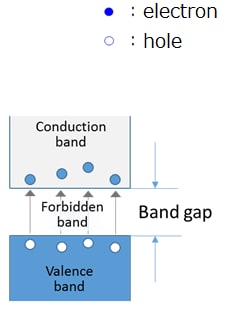- General Top
- SEMICONDUCTOR
- STORAGE
- COMPANY
-
My ToshibaSemicon
- Semiconductor Top
-
ApplicationsAutomotive
Body Electronics
xEV
In-Vehicle Infotainment
Advanced Driver-Assistance Systems (ADAS)
Chassis
IndustrialInfrastructure
BEMS/HEMS
Factory Automation
Commercial Equipment
Consumer/PersonalIoT Equipment
Healthcare
Wearable Device
Mobile
Computer Peripherals
-
ProductsAutomotive Devices
Discrete Semiconductor
Diodes
Transistors
Logic ICs
Analog Devices
Digital Devices
Wireless Devices
※
: Products list (parametric search)
Power SemiconductorsSiC Power Devices
※
: Products list (parametric search)
Isolators/Solid State RelaysPhotocouplers
Digital Isolators
Solid State Relays
Fiber Optic Transmitting Modules
※
: Products list (parametric search)
MOSFETsIGBTs/IEGTsBipolar Transistors※
: Products list (parametric search)
Diodes※
: Products list (parametric search)
MicrocontrollersMotor Driver ICsIntelligent Power ICs※
: Products list (parametric search)
Power Management ICsLinear ICs※
: Products list (parametric search)
General Purpose Logic ICsLinear Image SensorsOther Product ICsOther Product ICs
※
: Products list (parametric search)
-
Design & Development
-
Knowledge
- Where To Buy
- Part Number & Keyword Search
- Cross Reference Search
- Parametric Search
- Stock Check & Purchase
This webpage doesn't work with Internet Explorer. Please use the latest version of Google Chrome, Microsoft Edge, Mozilla Firefox or Safari.
require 3 characters or more. Search for multiple part numbers fromhere.
The information presented in this cross reference is based on TOSHIBA's selection criteria and should be treated as a suggestion only. Please carefully review the latest versions of all relevant information on the TOSHIBA products, including without limitation data sheets and validate all operating parameters of the TOSHIBA products to ensure that the suggested TOSHIBA products are truly compatible with your design and application.Please note that this cross reference is based on TOSHIBA's estimate of compatibility with other manufacturers' products, based on other manufacturers' published data, at the time the data was collected.TOSHIBA is not responsible for any incorrect or incomplete information. Information is subject to change at any time without notice.
require 3 characters or more.
What is a wide-band-gap semiconductor?

The energy required for electrons and holes to transition from the valence band to the conduction band is called a band gap. Si (Silicon) has a band gap of 1.12 eV (electron volt). A semiconductor with a large value is called a wide-band-gap semiconductor. SiC (Silicon Carbide) and GaN (Gallium Nitride) are wide-band-gap semiconductors.
Physical property constants of typical semiconductor materials are shown in the table below.
Since wide-band-gap semiconductors have small lattice constants, the bond strength between atoms becomes strong. This means high electric breakdown field and thermal conductivity.
The band gap of 4H-SiC is 3.26 eV, and the electric breakdown field is 2.8 × 106, which is a very large value compared with that of Si, 3 × 105.
Physical property constants of Si and main wide-band-gap semiconductors
| Property | Unit | Si | 4H-SiC | 6H-SiC | 3C-SiC | GaN | GaAs | Diamond |
|---|---|---|---|---|---|---|---|---|
| Band gap | eV | 1.12 | 3.26 | 3.02 | 2.23 | 3.39 | 1.43 | 5.47 |
| Electron mobility μe | cm2/Vs | 1400 | 1000/1200 | 450/100 | 1000 | 900 | 8500 | 2200 |
| Hole mobility μh | 600 | 120 | 100 | 50 | 150 | 400 | 1600 | |
Electric breakdown field Ec |
V/cm | 3.0×105 | 2.8×106 | 3.0×106 | 1.5×106 | 3.3×106 | 4.0×105 | 1.0×107 |
| Thermal conductivity λ | W/cmK | 1.5 | 4.9 | 4.9 | 4.9 | 2.0 | 0.5 | 20 |
Saturated electron drift velocity Vsat |
cm/s | 1.0×107 | 2.2×107 | 1.9×107 | 2.7×107 | 2.7x107 | 2.0×107 | 2.7×107 |
Relative dielectric constant ε |
11.8 | 9.7/10.2 | 9.7/10.2 | 9.7 | 9.0 | 12.8 | 5.5 |

